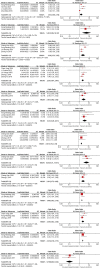Influencing factors of falls among older adults in Chinese retirement institutions: A systematic review and meta-analysis
- PMID: 38150433
- PMCID: PMC10752530
- DOI: 10.1371/journal.pone.0296348
Influencing factors of falls among older adults in Chinese retirement institutions: A systematic review and meta-analysis
Abstract
Background: The incidence of falling has always been high among the elderly, and it was easy to cause injuries to the elderly and seriously affect their quality of life. There were many studies have been conducted on risk factors affecting the fall of the elderly, but the results widely, retirement institutions as a gathering place for the elderly, there was currently no comprehensive analysis of the factors related to elderly falls in pension institutions. This study aimed to explore the influencing factors of falls among older adults in Chinese nursing homes.
Methods: Chinese and English databases were searched for literature published from database inception to 5 April 2023 on the influencing factors of falls among older adults in Chinese nursing homes. Two reviewers independently screened articles, extracted data, and assessed the quality of the included studies. Meta-analysis was performed using RevMan 5.4 software.
Results: Eleven studies involving 3503 participants were included in the meta-analysis. The pooled estimate of falls among older adults in Chinese nursing homes was 32% [95% confidence interval (95%CI) (24.0%, 39.0%)]. The main influencing factors for falls among older adults in Chinese nursing homes were age (Odds Ratio (OR) = 1.53), gender (OR = 5.50), visual impairment (OR = 2.30), sedative-hypnotics (OR = 2.36), fear of falling (OR = 2.95), hypertension (OR = 3.72), static balance (OR = 2.02), three or more chronic diseases (OR = 5.63), cognitive status (OR = 2.64), walking aid use (OR = 1.98), fall-related chronic diseases (OR = 2.48), self-awareness of abilities (OR = 2.43), and frequent reminders for fall prevention (OR = 0.10).
Conclusion: Falls among older adults in Chinese nursing homes were common, and there were many influencing factors. Timely screening and intervention should be implemented to reduce the adverse consequences of falls on older adults.
Trial registration: Registration number: CRD42023421099.
Copyright: © 2023 Huang et al. This is an open access article distributed under the terms of the Creative Commons Attribution License, which permits unrestricted use, distribution, and reproduction in any medium, provided the original author and source are credited.
Conflict of interest statement
The authors have declared that no competing interests exist.
Similar articles
-
Prevention of falls and fall-related injuries in community-dwelling seniors: an evidence-based analysis.Ont Health Technol Assess Ser. 2008;8(2):1-78. Epub 2008 Oct 1. Ont Health Technol Assess Ser. 2008. PMID: 23074507 Free PMC article.
-
Shock-absorbing flooring for fall-related injury prevention in older adults and staff in hospitals and care homes: the SAFEST systematic review.Health Technol Assess. 2022 Jan;26(5):1-196. doi: 10.3310/ZOWL2323. Health Technol Assess. 2022. PMID: 35089119
-
Falls among older adults with sarcopenia dwelling in nursing home or community: A meta-analysis.Clin Nutr. 2020 Jan;39(1):33-39. doi: 10.1016/j.clnu.2019.01.002. Epub 2019 Jan 8. Clin Nutr. 2020. PMID: 30665817 Review.
-
Fall prevention in community-dwelling adults with mild to moderate cognitive impairment: a systematic review and meta-analysis.BMC Geriatr. 2021 Dec 10;21(1):689. doi: 10.1186/s12877-021-02641-9. BMC Geriatr. 2021. PMID: 34893027 Free PMC article.
-
The (cost-)effectiveness of an implemented fall prevention intervention on falls and fall-related injuries among community-dwelling older adults with an increased risk of falls: protocol for the in balance randomized controlled trial.BMC Geriatr. 2021 Jun 23;21(1):381. doi: 10.1186/s12877-021-02334-3. BMC Geriatr. 2021. PMID: 34162353 Free PMC article.
Cited by
-
Gender-Specific Patterns of Injury in Older Adults After a Fall from a Four-Wheeled Walker (Rollator): Retrospective Study from a Swiss Level 1 Trauma Centre.Int J Environ Res Public Health. 2025 Jan 22;22(2):143. doi: 10.3390/ijerph22020143. Int J Environ Res Public Health. 2025. PMID: 40003369 Free PMC article.
-
Prevalence and risk factors of falls in people on hemodialysis: a systematic review and meta-analysis.Ren Fail. 2025 Dec;47(1):2485375. doi: 10.1080/0886022X.2025.2485375. Epub 2025 Apr 9. Ren Fail. 2025. PMID: 40204427 Free PMC article.
-
Incidence and Factors Associated with Falls in Older People in a Long-Term Care Facility: A Prospective Study in Taiwan.Healthcare (Basel). 2024 May 7;12(10):959. doi: 10.3390/healthcare12100959. Healthcare (Basel). 2024. PMID: 38786371 Free PMC article.
-
Trends in injury-related mortality among residents of Jiangsu Province from 2012 to 2021: an age-period-cohort analysis.Front Public Health. 2024 Jun 11;12:1373238. doi: 10.3389/fpubh.2024.1373238. eCollection 2024. Front Public Health. 2024. PMID: 38919918 Free PMC article.
References
-
- Zhenwu Zhai, Wenli Liu. Quality of the Seventh National Census Data and the New "Changes" in China’s Population. Population Research. 2021;45(03): 46–56.
-
- Xiaoyun Mu, Jiang Du, Yanli Ding, et al.. Investigation on the Risk Factors of Falls in Elderly People in Nursing Homes in Shenyang City. Nursing Research. 2014;28(21): 2598–2600. doi: 10.3969/j.issn.10096493.2014.21.012 - DOI
-
- Wen Yan, Xuemei Zhang, Qian Chen. Study on the Effectiveness of Fall Prevention and Its Influencing Factors in Elderly People in Nursing Homes. Chinese Journal of General Practice. 2019; 22(19): 2356–2360. doi: 10.12114/j.issn.1007-9572.2019.00.324 - DOI
-
- Gibson M J, Andres R O, Kennedy T E, et al.. Kellogg International Work Group on the Prevention of Falls by the Elderly. The prevention of falls in later life Danish Medical Bulletin. 1987;34(4): 1–24. - PubMed
-
- Lian Hao, Sheng Li, Fang Xiang, et al.. Time Trend Analysis of the Falling Mortality Rate in China from 2003 to 2018. Modern Preventive Medicine. 2020; 47(23): 4357–4360.
Publication types
MeSH terms
LinkOut - more resources
Full Text Sources
Medical
Miscellaneous




